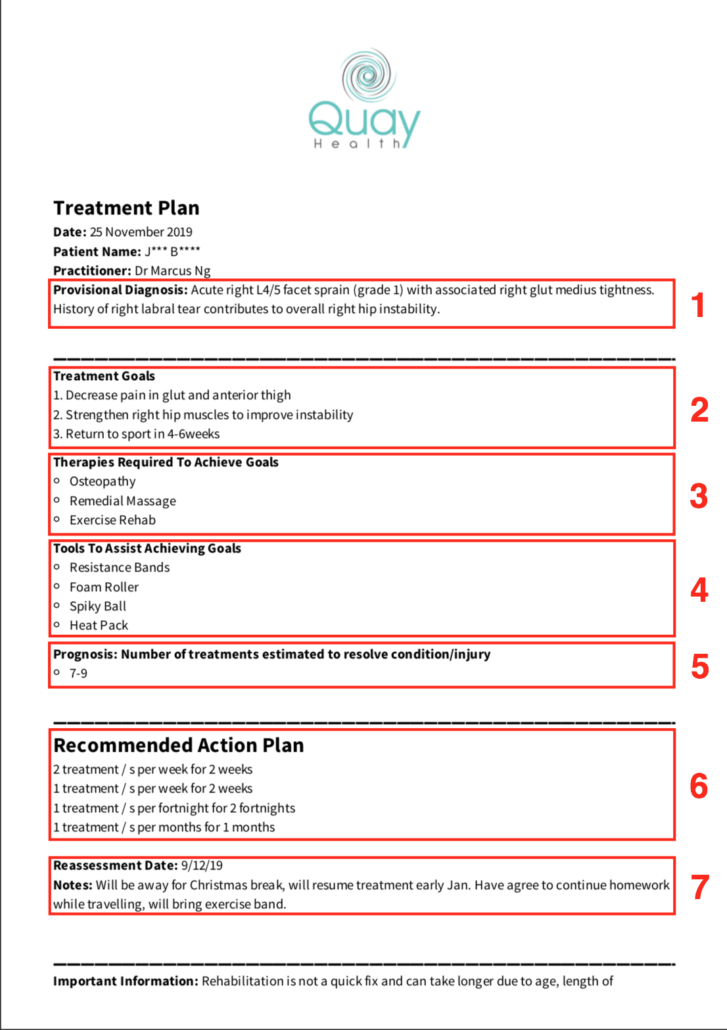By Sydney CBD Osteopath Dr Marcus Ng
A treatment plan will be sent to you after an initial consultation with one of Quay Health’s Osteopaths, Chiropractors or physiotherapists. What is a treatment plan? What do we need a treatment plan? Who is the treatment plan for? When do we use a treatment plan? How do we use a treatment plan? In this blog we will answer all questions relating to treatment plans.

What is a treatment plan?
A treatment plan is a document that is sent via email after your first osteo, chiro or physio appointment. It will provide all the necessary details on the following:
- Provisional Diagnosis – this is based on the history-taking and physical assessment. It will address the structure/s that are causing the underlying issue.
- Treatment Goals – this address the outcomes we want to achieve. Short, medium and long term goals. This will be based on the severity of the condition and whether it’s an acute or chronic issue.
- Therapies Required To Achieve Goals – this outlines the types of intervention we want to use. For osteopathy, it will be a combination of active and passive forms of treatment.
- Tools To Assist Achieving Goals – the tools and apparatus to help you with doing prescribed rehab exercises. Most common tools are things like exercise bands and foam rollers.
- Prognosis – the number of estimated total sessions needed to address the diagnosis. This will be based on the severity of the condition and whether it’s an acute or chronic issue.
- Recommended Action Plan – the number of sessions and the frequency needed to address the diagnosis. This is based on the individual’s condition, examination results and the experience of the clinician in dealing with similar cases.
- Other Relevant information – this includes the reassessment date and other information that may affect the action plan.

Why do we need a treatment plan?
A treatment plan is necessary because it serves as a roadmap for recovery and achieving your goals. It outlines the diagnosis, what intervention is required and the estimated timeframe on recovery or improvements will occur.
A treatment plan should always address the initial symptoms AND address the underlying condition causing these symptoms. Injury prevention is the ultimate outcome, and by setting out the treatment goals into short, medium and long term goals we can address each stage of the recovery as required.
Most commonly, the short term or acute stage is to get patient out of pain and or improve their quality and range of motion. The pain and lack of motion is the most common reason why people seek osteo, physio and chiro help.
Medium term goals are typically addressing contributing factors and clinical findings… The contributing factors could be activities of daily living that need to be modified to stop it from perpetuating the symptoms.
Clinical findings are the interpretations of any functional tests the osteo, physio or chiro diagnose during the examination.
Lastly, the Long term goals should ultimately be injury prevention and/or maintenance, keeping you at a state where you can live your best life, doing the things you enjoy without hesitation or restrictions.

Who is the treatment plan for?
It is a document that has been discussed at the initial appointment between clinician and client. It is an action plan that can be referred to from time to time to track the progress.
The treatment plan is tailored to the individual based on the clinician’s history-taking and physical assessment at the first osteo appointment. The recommendations are based on the individual’s condition, examination results and the experience of the clinician in dealing with many cases, some similar to the client.
When do we use a treatment plan?
The treatment plan will outline the estimated number of sessions and the how often the sessions are required. The recommended action plan is a guide and will be modified if required as your condition changes. It is important information for you to learn and understand about your condition. When you understand what you have; why you have it; how to treat it and when to treat it; you are much more likely to respond positively to your treatments and be compliant with your treatments. It allows both the practitioner and the client to have clear communication and understanding on what we hope to achieve.
How do we use the treatment plan?
You can follow the treatment plan by:
- Attending your treatment appointments as suggested
- Be an active participant in your own recovery by doing the exercise rehab between your appointments.
The clinician will demonstrate each exercise with you in-session, thereafter a program of stretching and strengthening exercises will be tailored to you via PhysiApp.
PhysiApp is a free-to-download and free-to-use App that allows our clinician to track your progress and edit exercises as required.
It is an extremely useful tool for the both client and clinician. For the client, it has all the exercises listed along with video instruction which includes the sets, hold, reps counts. For the clinician, it allows us to track your progress and compliance and we can make adjustments as necessary.




